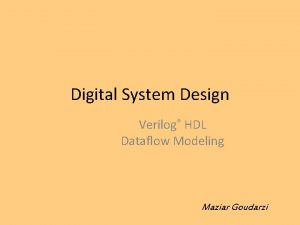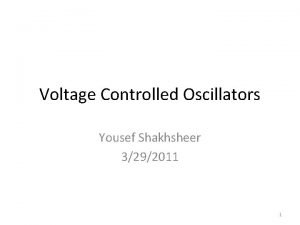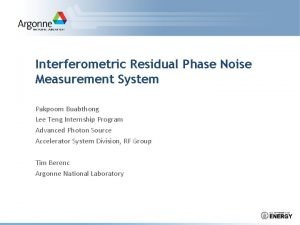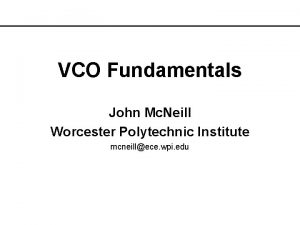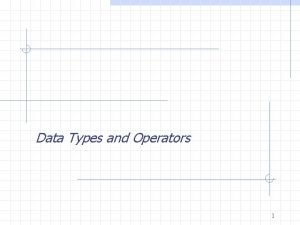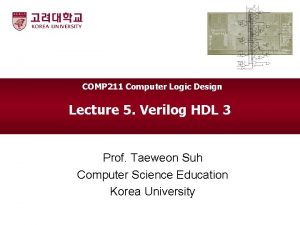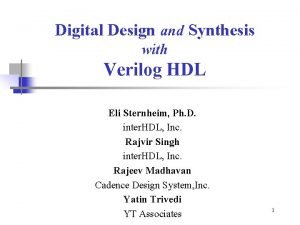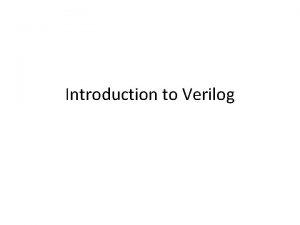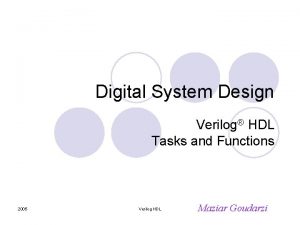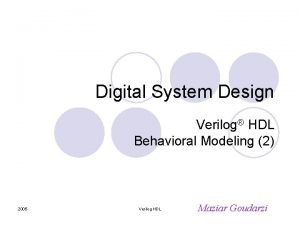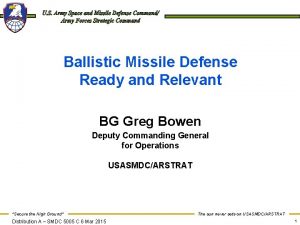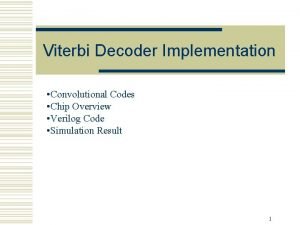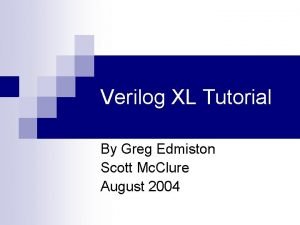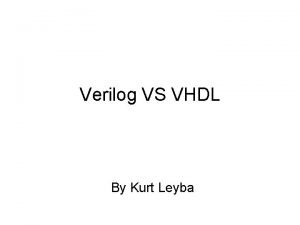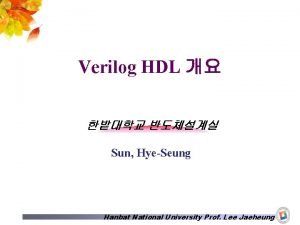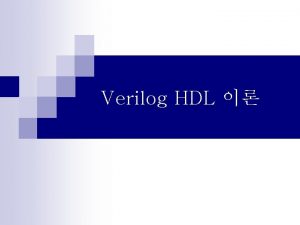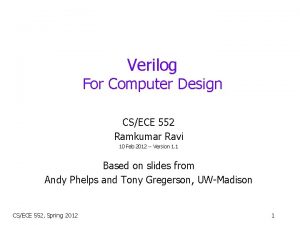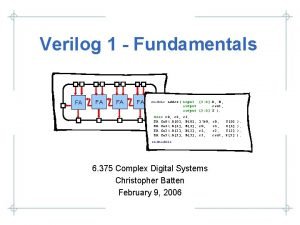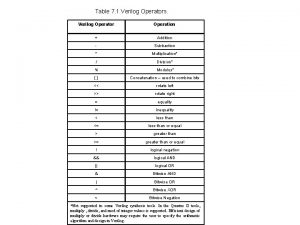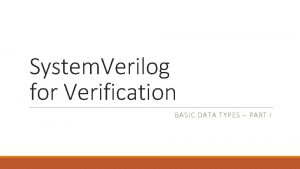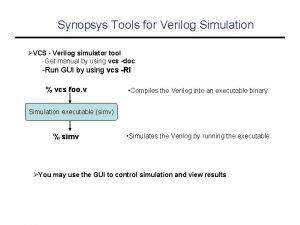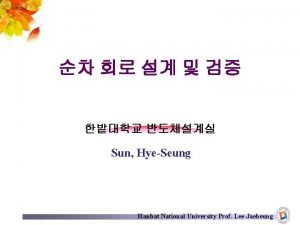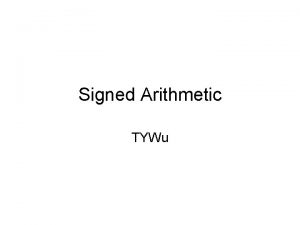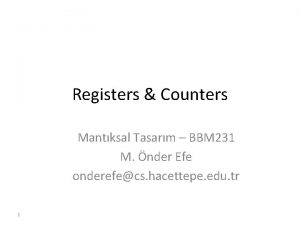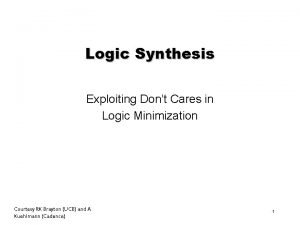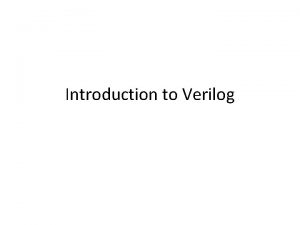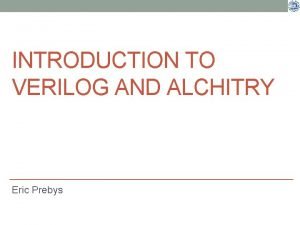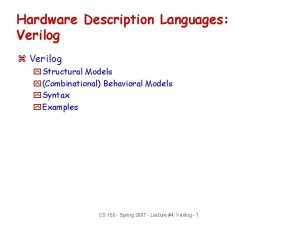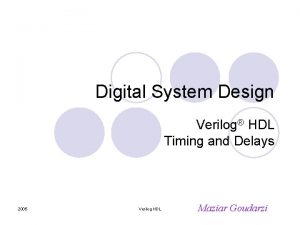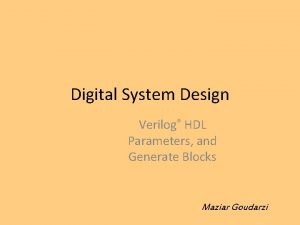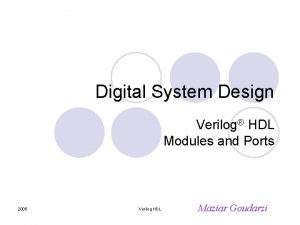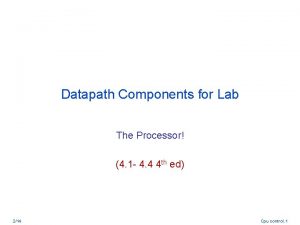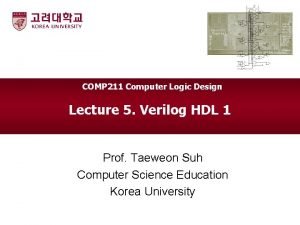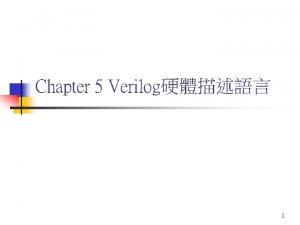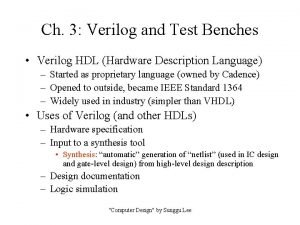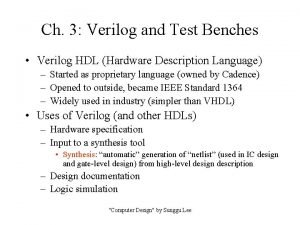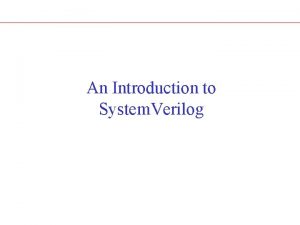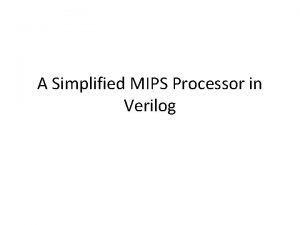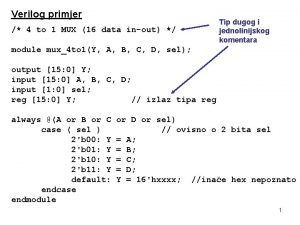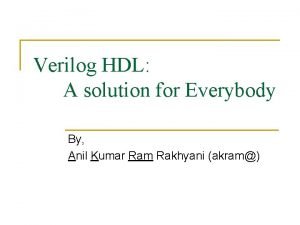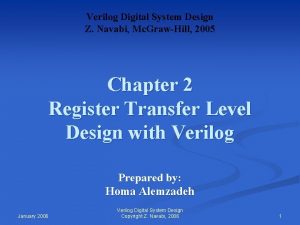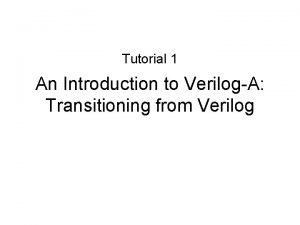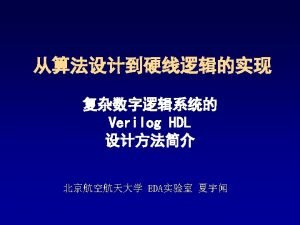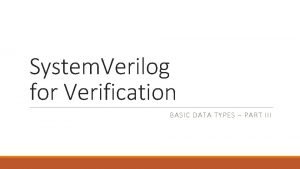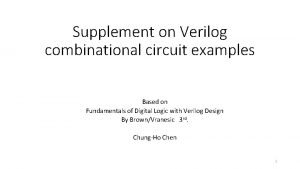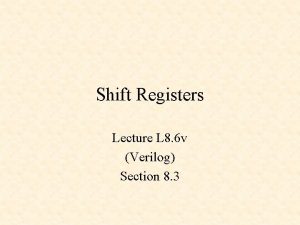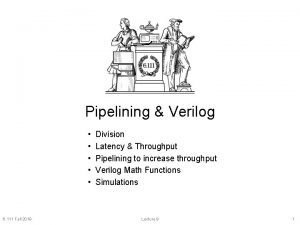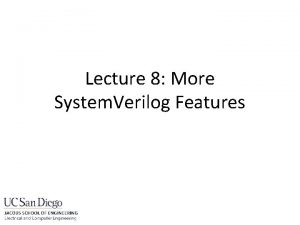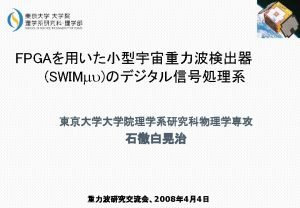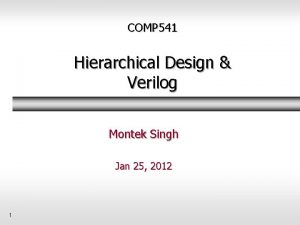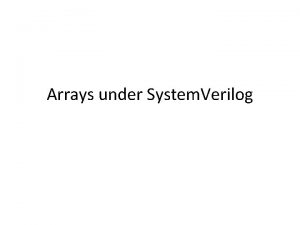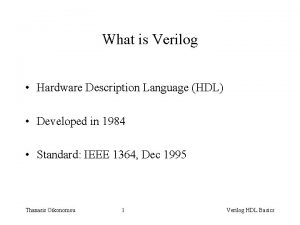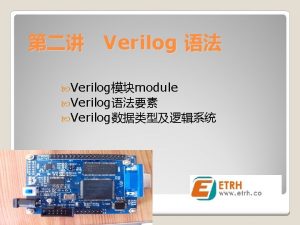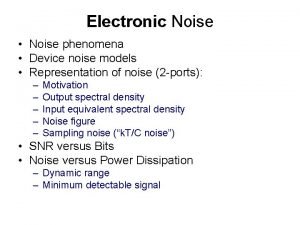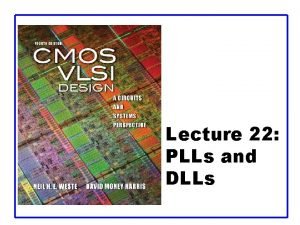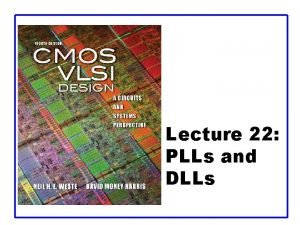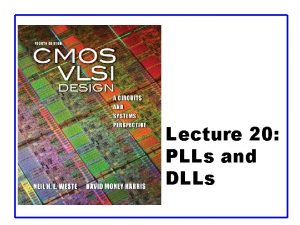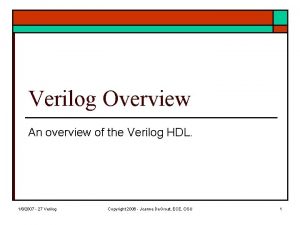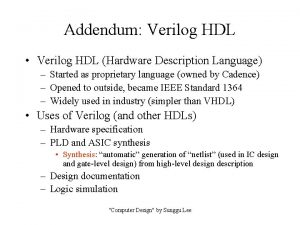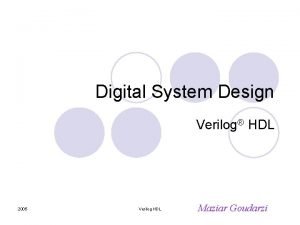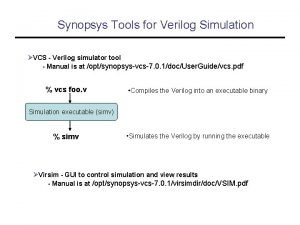PLLs and Phase Noise Modeling in Verilog GREG
















































































- Slides: 80

PLL’s and Phase Noise Modeling in Verilog GREG WARWAR MAY 22, 2018

Outline ◦ Matrix based circuit solvers ◦ Clocks and oscillators ◦ Implementing an oscillator in Verilog with jitter ◦ Simulating oscillators in SPICE/Spectre/Eldo ◦ Accuracy, Simulation Time, Verilog-A, Simulation tool differences ◦ Phase Lock Loop example in Verilog

SPICE Circuit Analysis – 3 “nodes”

SPICE – Another 3 -“node” Circuit

SPICE – Another 3 -“node” Circuit Tolerance settings determine size of “h” Tolerance also determine accuracy of non-linear elements

SPICE: Two Non-Coupled Circuits

SPICE: Two Non-Coupled Circuits – Combined Matrix

SPICE: Two Non-Coupled Circuits – Combined Matrix • Zeros “fill in” as maxtrix is solved • Uncoupled equations become coupled via numerical roundoff / noise

Oscillators • • Delay around ring one time is (6 D) One period requires going around the ring twice T = 12 D The frequency of the oscillator is f = 1/T The ring requires an odd number of inversions

Oscillators Force an initial condition • • Delay around ring one time is (6 D) One period requires going around the ring twice T = 12 D The frequency of the oscillator is f = 1/T The ring requires an odd number of inversions

Oscillators – Open Switch 0 Open Switch – signal starts propagating • • Delay around ring one time is (6 D) One period requires going around the ring twice T = 12 D The frequency of the oscillator is f = 1/T The ring requires an odd number of inversions

Oscillators – Open Switch 1 Open Switch – signal starts propagating • • Delay around ring one time is (6 D) One period requires going around the ring twice T = 12 D The frequency of the oscillator is f = 1/T The ring requires an odd number of inversions

Oscillators – Open Switch 2 Open Switch – signal starts propagating • • Delay around ring one time is (6 D) One period requires going around the ring twice T = 12 D The frequency of the oscillator is f = 1/T The ring requires an odd number of inversions

Oscillators – Open Switch 3 Open Switch – signal starts propagating • • Delay around ring one time is (6 D) One period requires going around the ring twice T = 12 D The frequency of the oscillator is f = 1/T The ring requires an odd number of inversions

Oscillators – Open Switch 4 Open Switch – signal starts propagating • • Delay around ring one time is (6 D) One period requires going around the ring twice T = 12 D The frequency of the oscillator is f = 1/T The ring requires an odd number of inversions

Oscillators – How do we simulate in Verilog 50 ps • • D D

Oscillators – How do we simulate in SPICE ~100 ps

Oscillators – Key Properties • Frequency • • • Center frequency fo Frequency range fmax – fmin Frequency vs. Control_Voltage kv [GHz/V] • Phase • • • Phase is the delay of a clock relative to an ideal master Phase is measured in [ps], [deg], [rad], [periods] Phase is the integral of frequency • Jitter • • Jitter is variation of the phase with time Jitter is key performance metric of a precision clock

Oscillators – (Before Adding Jitter) 50 ps • • D D

Oscillators – Add Simple Jitter in Verilog – (t = 0) 50 ps • • D D

Oscillators – Add Simple Jitter in Verilog – (0 < t < 200 n) 50 ps • • D D

Oscillators – Add Simple Jitter in Verilog – (t = 200 n) 50 ps • • D D

Oscillators – Add Simple Jitter in Verilog – (0 < t < 200 n) • • D D

Why not just use SPICE? ? ◦ Isn’t it more accurate? ◦ Can’t you just put some blocks in “Verilog-A” and go fast?

Why do we simulate PLL’s and Clocks? ? ◦ Study initialization and other transient conditions ◦ Study interfaces between asynchronous clock domains ◦ FIFO’s, clock phase alignment circuits ◦ Study PLL’s in the time domain ◦ Instability, or “run-away” problems due to nonlinear elements ◦ Clock recovery circuits with nonlinear control loops ◦ Verification of top level designs containing PLL’s ◦ Study jitter generation and propagation

Intermission - Find your inner self Am I an analog or digital guy / gal?

Intermission - Find your inner self #1

Intermission - Find your inner self #1 j +1 point Analog

Intermission - Find your inner self #1 j i +1 point Analog +1 point Digital

Intermission - Find your inner self #1 j i ERROR +1 point Analog +1 point Digital +2 points Digital

Intermission - Find your inner self #1 j i ERROR 90° +1 point Analog +1 point Digital +2 points Analog

Intermission - Find your inner self #2 What is the x-axis?

Intermission - Find your inner self #2 What is the x-axis? frequency +1 point Analog

Intermission - Find your inner self #2 What is the x-axis? frequency time +1 point Analog +1 point Digital

Intermission - Find your inner self #2 What is the x-axis? frequency time cycle +1 point Analog +1 point Digital +2 points Digital

Intermission - Find your inner self #3 What is the units of y-axis?

Intermission - Find your inner self #3 What is the units of y-axis? d. B volts Anything you can count Errors, hits, collisions, … +1 point Analog +1 point Digital +2 points Digital

Intermission - Find your inner self #4 If (x == 8. 3) {. . . } What’s wrong with this code?

Intermission - Find your inner self #4 If (x == 8. 3) {. . . } Nothing What’s wrong with this code? +1 point Analog

Intermission - Find your inner self #4 If (x == 8. 3) {. . . } Nothing Internal Roundoff What’s wrong with this code? +1 point Analog +1 point Digital

Why not just use SPICE? ? ◦ Isn’t it more accurate? ◦ Can’t you just put some blocks in “Verilog-A” and go fast?

Why do we simulate PLL’s and Clocks? ? ◦ Study initialization and other transient conditions ◦ Study interfaces between asynchronous clock domains ◦ FIFO’s, clock phase alignment circuits ◦ Study PLL’s in the time domain ◦ Instability, or “run-away” problems due to nonlinear elements ◦ Clock recovery circuits with nonlinear control loops ◦ Verification of top level designs containing PLL’s ◦ Study jitter generation and propagation

What about Verilog-A ? ? Looks like Verilog Language supports triggered events

What about Verilog-A ? ? Looks like Verilog Language supports triggered events Still has to be resolved down to a matrix!!!

Oscillators – Accuracy in SPICE / Spectre / Eldo ~100 ps Benchmark Test • Run 11 us • Measure total jitter for (1 us < t < 10 us) • Tolerance [conservative, moderate, liberal]

Oscillators – Accuracy in Eldo - 1 ~100 ps F = 7. 489851 e+08 J = 2. 916330 e-16 T = 0 -min 50 -sec

Oscillators – Accuracy in Eldo - 4 ~100 ps F = 7. 301669 e+08 J = 9. 534742 e-17 T = 2 -min 25 -sec

Oscillators – Accuracy in Eldo - 7 ~100 ps F = 7. 572305 e+08 J = 1. 427320 e-11 T = 5 -min 10 -sec* F = 7. 316815 e+08 J = 9. 628039 e-11 T = 5 -min 10 -sec*

Oscillators – Accuracy in Eldo - 8 ~100 ps F = 7. 583032 e+08 J = 2. 905199 e-11 T = 12 -min 6 -sec* F = 7. 369350 e+08 J = 1. 422838 e-10 T = 12 -min 6 -sec* F = 7. 591970 e+08 J = 2. 556108 e-11 T = 12 -min 6 -sec* F = 7. 681427 e+08 J = 1. 590278 e-10 T = 12 -min 6 -sec*

Oscillators – Accuracy in Spectre - 1 ~100 ps F = 7. 530338 e+08 J = 2. 281258 e-12 T = 2 -min 18 -sec

Oscillators – Accuracy in Spectre - 2 ~100 ps F = 7. 538988 e+08 J = 1. 401772 e-12 T = 2 -min 18 -sec

Oscillators – Accuracy in Spectre - 3 ~100 ps F = 7. 532945 e+08 J = 1. 346296 e-11 T = 4 -min 23 -sec* F = 7. 540933 e+08 J = 1. 108888 e-11 T = 4 -min 23 -sec*

Oscillators – Accuracy in Spectre - 4 ~100 ps F = 7. 697708 e+08 J = 5. 517425 e-18 T = 0 -min 49 -sec

Oscillators – Accuracy in Spectre - 5 ~100 ps F = 8. 067968 e+08 J = 3. 129376 e-18 T = 0 -min 58 -sec

Oscillators – Accuracy in Spectre - 6 ~100 ps F = 7. 697708 e+08 J = 5. 501316 e-15 T = 1 -min 56 -sec* F = 8. 067968 e+08 J = 1. 626288 e-15 T = 1 -min 56 -sec*

Oscillators – Accuracy in Spectre - 7 ~100 ps F = 7. 551702 e+08 J = 6. 855988 e-13 T = 4 -min 47 -sec* F = 7. 697708 e+08 J = 2. 811061 e-15 T = 4 -min 47 -sec*

Oscillators – Accuracy in Spectre - 8 ~100 ps F = 7. 558547 e+08 J = 9. 740328 e-12 T = 11 -min 5 -sec* F = 7. 697708 e+08 J = 7. 345695 e-15 T = 11 -min 5 -sec* F = 7. 567189 e+08 J = 7. 581477 e-12 T = 11 -min 5 -sec* F = 8. 067968 e+08 J = 3. 472637 e-15 T = 11 -min 5 -sec*

Eldo / Spectre Summary §Eldo has more trouble with Verilog-A § § Verilog-A ~ 3 x slower than transistors !!! Timing accuracy of Verilog-A is essentially broken §Spectre has better handling of Verilog-A § § § Verilog-A ~ 2 x faster than transistors Timing accuracy of Verilog-A is realiable Presence of Verilog-A cells degrades accuracy transistors

Simulator Types ▶ Verilog is an event driven simulator ─ Time is internally stored as a 64 -bit integer. ─ `timestep 1 ns/1 fs • • ▶ ▶ This indicates that each LSB of time is 1 fs The user unit of time is 1 ns, but internally this is unimportant. All events are “snapped” to a simulator time unit. ─ Other than “snapping”, no roundoff or numerical error in time calculation Spectre, Eldo, HSPICE, (Verilog-A) are timestep simulators ─ Timestep simulators do not solve equations exactly ─ Iterate until (error < “vntol”)

Data Types in Verilog ▶ Time is interally stored as 64 -bit integer ─ Using 1 fs time unit, the largest time possible • ▶ ▶ ▶ 2^64*1 fs = 18446 seconds = 5 hr – 7 min Integers are 32 -bit Reals and Parameter are double-precision ─ ~ 16 -digits > 300 d. B dynamic range Use Reals where necessary to avoid “time snapping” ─ Especially important in VCO’s and clock sources !!!!

Verilog Code for Clock Sources

Verilog Code for Clock Sources

Verilog Code for Clock Sources This little bit of code only uses reals to calculate next. Time, which thus has no snapping truncation error

Noise Model Strategy ▶ ▶ The “$random” verilog function produces a random 32 -bit value We can make a uniform random value from -227 to 227 ─ $random % 134217728 (227 = 13417728) ─ We can make a gaussian random number with a sigma of 227 by adding 12 of these and dividing by 2. (Scaling by 227 avoids the possibility of overflow when adding 12 of these together. ─ Finally, we divide by 227 to get a random value with a sigma of 1. 0 The uniform random variable … ─ Has its energy spread evenly from 0 to fs/2. C ─ Can be passed through a low pass filter to create white noise with a desired cutoff frequency. We model 1/f noise by … ─ Use three white noise sources summed in a stair-step fashion ─ Typical cutoff frequencies of 100 k, 1. 0 M, and 10. 0 M












run 1

run 1

run 2

run 2

Conclusion ▶ ▶ ▶ Verilog provides and ideal platform for studying precision timing circuits and systems Event driven simulation has significant advantages over an integration based solver (matrix solution) ─ Well behaved and easily avoidable round off effects ─ Orders of magnitude fasters for long simulations ─ Compatible with chip level verification flow Verilog-A is similar in appearance to Verilog, but is still resides in the matrix based circuit simulation tools. ─ Non-trivial to implement, and robustness varies widely Thank you!
 Dataflow verilog
Dataflow verilog Helen c. erickson nursing theory
Helen c. erickson nursing theory Pcm companding
Pcm companding Dimensional modeling vs relational modeling
Dimensional modeling vs relational modeling Oscillator phase noise 50low
Oscillator phase noise 50low Residual phase noise
Residual phase noise John mcneill wpi
John mcneill wpi Mobile phase and stationary phase
Mobile phase and stationary phase Mobile phase and stationary phase
Mobile phase and stationary phase Adsorption chromatography
Adsorption chromatography Normal phase vs reverse phase chromatography
Normal phase vs reverse phase chromatography M tswett pronunciation
M tswett pronunciation Normal phase vs reverse phase chromatography
Normal phase vs reverse phase chromatography Power formula three phase
Power formula three phase Phase to phase voltage
Phase to phase voltage Csce 441
Csce 441 Verilog data types and operators
Verilog data types and operators Traffic light controller verilog code and testbench
Traffic light controller verilog code and testbench Cache verilog
Cache verilog Verilog data types and operators
Verilog data types and operators Functional bifurcation in verilog
Functional bifurcation in verilog Verilog hdl
Verilog hdl Verilog
Verilog Greg and the ballistic missile
Greg and the ballistic missile Spontaneous generation in data flow diagram
Spontaneous generation in data flow diagram Modeling with quadratic functions
Modeling with quadratic functions Typical process description tools include
Typical process description tools include Viterbi decoder verilog code
Viterbi decoder verilog code Verilog-xl
Verilog-xl Verilog hdl vs vhdl
Verilog hdl vs vhdl 베릴로그 assign
베릴로그 assign Verilog
Verilog Verilog case문
Verilog case문 Non synthesizable constructs in verilog
Non synthesizable constructs in verilog Verilog
Verilog Verilog operators table
Verilog operators table Tri verilog
Tri verilog Synopsys verilog simulator
Synopsys verilog simulator 16 bit divider verilog code
16 bit divider verilog code Verilog signed addition
Verilog signed addition Q a 1
Q a 1 Systemverilog nettype
Systemverilog nettype 32 bit alu verilog
32 bit alu verilog Verilog dont care
Verilog dont care Verilog structure
Verilog structure Intro to verilog
Intro to verilog Logic comparators
Logic comparators Types of delays in verilog
Types of delays in verilog Nested generate verilog
Nested generate verilog Verilog
Verilog Datapath components
Datapath components Difference between arithmetic shift and logical shift
Difference between arithmetic shift and logical shift Verilog timescale 設定
Verilog timescale 設定 Test bench in verilog
Test bench in verilog Test bench in verilog
Test bench in verilog System verilog
System verilog Mips processor verilog
Mips processor verilog Verilog 7 segment display
Verilog 7 segment display Xterm moba
Xterm moba 4 mux
4 mux Moore machine verilog code
Moore machine verilog code Verilog coding style
Verilog coding style Hdl code
Hdl code Digital system design using verilog
Digital system design using verilog Veriloga tutorial
Veriloga tutorial Verilog hdl
Verilog hdl System verilog union
System verilog union Combinational circuit verilog
Combinational circuit verilog Verilog bubble sort
Verilog bubble sort Verilog shift register
Verilog shift register Verilog pipeline example
Verilog pipeline example Procedural statement
Procedural statement Carry select adder verilog
Carry select adder verilog Verilog display format
Verilog display format Language
Language Verilog debounce
Verilog debounce Hierarchical design in verilog
Hierarchical design in verilog Verilog structural vs behavioral
Verilog structural vs behavioral Systemverilog multidimensional array initialization
Systemverilog multidimensional array initialization Advanced digital design with the verilog hdl
Advanced digital design with the verilog hdl Verilog
Verilog
